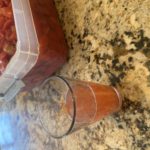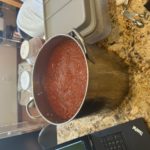But, if you’re like me, you’ll probably want to make a lot more. Below you’ll find the details of my fresh salsa recipe. Making salsa has become a late-June to early-July ritual that provides us with salsa through the winter and beyond. In the MS delta, the garden yields it’s fruit about this time of year depending on exact planting times and spring weather. Please use the recipe as a starting point and get creative. This recipe is slightly above average in terms of heat level. I try to keep it reasonable and shoot for medium heat. I then add habaneros, serranos or cayenne peppers when I serve the salsa depending on the preferences of my guests. My wife always complains about the heat while shes eating the stuff like it’s her last meal. Let me know if you come across an ingredient or change that makes it better. Have fun.
Anchors Curve Fresh Salsa Recipe – Makes 4 gallons
Wet ingredients:
25 Lbs. clean quartered tomatoes (this is a case/box of tomatoes at the market)
12 oz. apple cider vinegar
1-gallon Ziplock bag banana peppers (any brightly colored sweet pepper will do)
16 oz. roasted New Mexico green chiles (these are hot – another hot pepper will do)
8 rehydrated chipotle peppers (for smokey flavor – you can also use a can of chipotle in adobo from grocery store)
6 heads garlic
4 large white onions
6-7 limes (juice only)
Dry ingredients:
3 heaping TBSPs ground oregano
3 heaping TBSPs ground sage
1 heaping TBSP cumin powder
2 level TBSPs smoked paprika
½ cup turbinado sugar (white sugar is ok)
4 level TBSPs creole seasoning (I prefer Zatarain’s but Tony’s is also good)
1 level TBSP citric acid to reduce possibility of spoilage (This a recent addition but have never had a problem before)
1 – bunch of cilantro (optional and better if added at time of serving)
Kitchen Tools/Items needed
A really sharp kitchen knife
Food processor is best for this recipe. Blender will also work.
18 quart plastic food grade containers
Smaller containers to store some to eat right away
Directions:
Consider this a rough guide. Use a food processor to chop tomatoes, onions, peppers, garlic to the consistency you like. The more you process, the more sauce-like the salsa will be. I like it kind of chunky. Add the other wet and dry ingredients and mix thoroughly with a large spoon. This salsa will get better over time. If you can wait a week or so before starting to eat this, you will be rewarded.
Two batches are never the same as I taste as I go and adjust any ingredient that seems off. This recipe will yield about 4 gallons of salsa. I have two 18-quart Hefty plastic containers in which I store a about a years’ worth of salsa. 4 gallons will fit into one of these but it’s very full. We have an extra fridge and store two containers full of salsa there each summer at 35 degrees. With the vinegar, lime juice, citric acid, and cold temperature, there is very little chance of any spoilage. You can freeze the salsa but the tomatoes will release a lot of juice when thawed which reduces the volume of the salsa considerably (probably 25%). I’ve done it both ways and would rather not freeze due to the volume loss. However, if you do decide to freeze, the juice you strain off later makes an incredible Bloody Mary mix! Another processing/preserving option – cooking the salsa – turns the stuff into a catchup like product that I do not like – Like Pace picante sauce. Yuk!
This recipe will yield a salsa that is medium hot depending on your peppers. As mentioned above, I usually add hot peppers at the time of serving depending on my guests. Sometimes, I’ll serve the salsa “as-is” and a hotter version in another bowl so folks can choose between the two. At serving time, you can add additional salt if desired. However, I tend to go light on salt. Some chips have a good bit of salt on them and you don’t want to overdo it. If you find this recipe, please let me know what you think and let me know what adjustments you make to improve it. Cheers!



